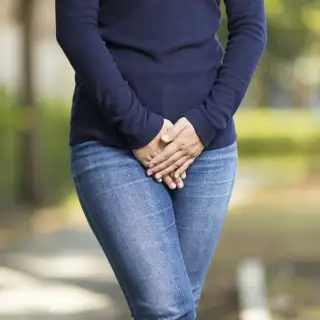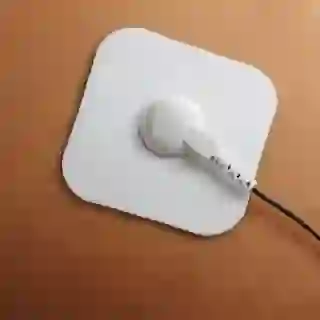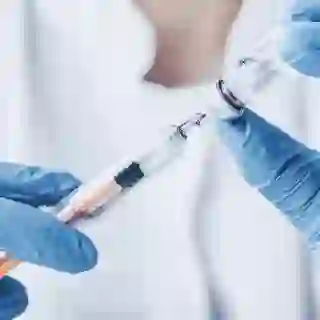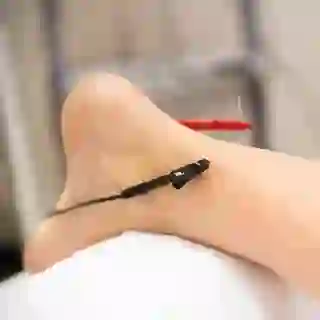If you are among the 30% of men or 40% of women in the United States who have a frequent and/or urgent need to “go” (known as overactive bladder or OAB), you’re probably wondering if this is just life now: planning your activities around the nearest bathroom. And while OAB can have many causes, from a neurological condition to enlarged prostate, and even pelvic-muscle changes from pregnancy and childbirth, it’s very likely there’s a treatment out there that can ease your symptoms. Let’s talk medically backed OAB treatment options first, then we’ll cover some common complementary therapies, too.

The Three Stages of OAB Treatment
First, you need to know that the goal of OAB treatment is to reduce your symptoms, not to eliminate them all together, says Maude Carmel, M.D., an associate professor of urology at UT Southwestern Medical Center in Dallas, TX. To set expectations, Dr. Carmel tells her patients: “If you have OAB, I can make you better, but not cure you.” That said, symptom reduction can mean significantly fewer trips to the bathroom. The American Urological Association recommends a three-line treatment strategy to help: behavioral changes first, medications second, and finally neural regulation therapies.

Behavior: Change Your Diet
This is going to take some work, but the payoff can be great. Dr. Carmel says 70% of her patients see symptom improvement with behavioral modifications alone. “If you don’t do this, any other treatment will not work,” she says. She recommends starting by limiting fluid intake to two liters spread throughout the day to reduce overall urine volume. Next, experiment with eliminating bladder-irritating foods and bevvies like alcohol, caffeine, artificial sweeteners, carbonated drinks, spicy food (we know, no fun!), citrus, tomatoes, and milk. Keeping a food diary can help you track how these foods affect your symptoms.

Behavior: Sweat More, Lose More
If you’ve been slipping on your new year’s diet and exercise resolutions, the promise of improved OAB symptoms might be the kick-in-the-pants you need. A study in the Open Access Journal of Urology found that weight loss of 5%-10% had an efficacy in women similar to that of other nonsurgical urinary incontinence treatments. Eating a balanced diet is key, but exercise is, too, says Diego Illanes, M.D., chief of urogynecology at Tufts Medical Center in Boston, MA. “Physical activity is proven to stimulate the central nervous system and causes weight reduction,” he says. “This translates to a healthy bladder.”
Behavior: Try Pelvic Floor Physical Therapy
Like your biceps and pecs, your pelvic floor—the muscle that supports your bladder—can be strengthened. No, they don’t make dumbbells for that, but there is a trainer who can help. A pelvic floor physical therapist can teach you to recruit and employ your pelvic floor muscles to stave off the urge to pee, says Addie Holzmann, D.P.T., physical therapist and owner of NeuMe Physio in Whispering Pines, NC. “If you’re going every hour we need to span it out to hit that two hour mark,” Holzmann says. After a few weeks of training, the goal is to gradually increase your bladder’s capacity.

Medications
If after a few months your OAB isn’t responding to your revamped lifestyle, your doctor will probably recommend medication. Anticholinergics, such as tolterodine, solifenacin, and oxybutynin, work by relaxing your bladder. Beta-3 agonists, like mirabegron, relax the smooth muscle around your bladder to increase its capacity (a tense bladder constantly sends “gotta go” signals to your brain). These drugs work well, says Dr. Carmel, but many people drop them after a year or so because of side effects, which can include constipation, dry mouth, headache, and sometimes confusion, in elderly patients. That’s when third-line, or neural regulation, treatments come into play.
Neural Regulation: Sacral Neuromodulation
This “pace-maker for the bladder” requires two office visits. During the first, under local anesthesia, your provider will insert a small electrode near your tailbone and next to your bladder. A thin wire comes out of your skin and connects to an external battery whose job it is to stimulate the sacral nerve to control bladder urge. If you see a goal of 50% symptom improvement within those first few days, you can then come back in and have the electrode permanently implanted, and the battery (some are the size of a thumb drive) placed in your buttock.
Neural Regulation: Botox Injections
Yep. The same Botox that smooths face wrinkles can decrease bladder sensation, allowing it to fill more fully before urge sets in. In an hour-long appointment your doctor will give you 10 to 20 injections directly in your bladder. It’s 80% effective, says Dr. Carmel, but you’ll need to come in for a re-up every six to 12 months. A rare side effect that turns many patients off is the small chance (about 5% per Dr. Carmel) of the Botox working too well, making it impossible to pee at all. This resolves when the Botox wears off but may require catheterization in the meantime.
Neural Regulation: Percutaneous Tibial Nerve Stimulation
If you don’t mind visiting your doctor office frequently, posterior tibial nerve stimulation (PTNS) is a non-invasive OAB treatment option that’s basically side-effect free. “It’s literally an acupuncture needle that we put on the side of the ankle and we connect it to a machine that sends a small electrical current to the tibial nerves,” says Dr. Carmel. This nerve stimulation can calm bladder sensation and decrease urgency and frequency. The catch is, you’ll need to repeat the process once a week for 12 weeks, plus maintenance sessions every four to six weeks.
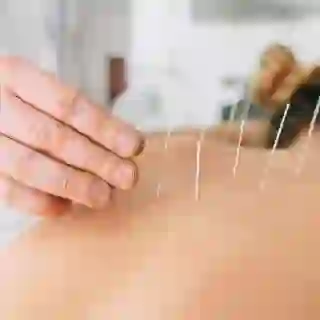
Complementary: Acupuncture
This ancient technique stimulates specific points on the body with fine needles to activate symptom-fighting chemicals. Studies have shown that acupuncture can increase the amount of urine your bladder can hold and reduce urgency and frequency. Dr. Illanes supports trying out alternative tactics like acupuncture, especially if traditional therapies aren’t helping. “If whatever I can offer from evidence-based medicine has not helped, then I tell my patients: Why don’t you just try it?” he says. Trouble is, insurance doesn’t usually cover it, but some practices offer group acupuncture at reduced rates.
Complementary: Supplements
Evidence supporting the use of supplements to control OAB is thin, but Dr. Illanes says it doesn’t hurt to try. For example, saw palmetto was shown to improve urgency, frequency, incontinence, and nocturia for men in one Japanese study. Plant-based resiniferatoxin may improve bladder capacity, and a Chinese herb blend called gosha-jinki-gan could decrease urgency, frequency, and nighttime urination, while pumpkin seed oil has been credited with strengthen pelvic floor muscles. It’s a good idea to ask your doctor before trying supplements. “They are not FDA-controlled, so we can’t prove the ingredients or dosage listed is correct,” Dr. Carmel says.

Complementary: Mental-Health Support
Bladder anxiety can keep some people from going out with friends or even being intimate with a partner, says Dr. Carmel, leading to feelings of isolation and often depression. So caring for your mental health by seeking support or therapy is important in treating OAB. In a small pilot study of women with drug-resistant OAB, a type of talk therapy called cognitive behavioral therapy helped with urinary symptoms and significantly improved anxiety and depression. “I do believe anything that is proven to improve your emotional life and physical condition, your bladder will benefit,” says Dr. Illanes.
OAB Statistics and Info: Urology Care Foundation. (n.d.) “Overactive Bladder (OAB).” https://www.urologyhealth.org/urology-a-z/o/overactive-bladder-(oab)
Three-Line Treatment Protocol: American Urological Association. (2019.) “Diagnosis and Treatment of Non-Neurogenic Overactive Bladder (OAB) in Adults: an AUA/SUFU Guideline.” https://www.auanet.org//guidelines-and-quality/guidelines/overactive-bladder-(oab)-guideline
Weight Loss for Incontinence: Open Access Journal of Urology. (2011.) “Effect of Weigh Loss on Urinary Incontinence in Women.” https://www.ncbi.nlm.nih.gov/pmc/articles/PMC3818946/
Medications for OAB: Mayo Clinic. (2020.) “Overactive Bladder.” https://www.mayoclinic.org/diseases-conditions/overactive-bladder/diagnosis-treatment/drc-20355721
Acupuncture: BMJ. (2014.) Acupuncture for Adults With Overactive Bladder: A Systemic Review Protocol.” https://bmjopen.bmj.com/content/5/1/e006756
Cognitive Behavioral Therapy for OAB: Lower Urinary Tract Symptoms. (2020.) “Clinical Feasibility and Acceptability of Adding Cognitive Behavioral Therapy to Pharmacotherapy for Drug-resistant Overactive Bladder in Women: A Single-arm Pilot Study.” https://onlinelibrary.wiley.com/doi/10.1111/luts.12333
Pumpkin Seed Oil: Journal of Traditional and Complementary Medicine. (2014.) “Pumpkin Seed Oil Extracted From Cucurbita Maxima Improves Urinary Disorder in Human Overactive Bladder.”
Saw Palmetto: Food Science & Nutrition. (2020.) “Effects of Saw Palmetto Fruit Extract Intake on Improving Urination Issues in Japanese Men: A Randomized, Double‐blind, Parallel‐group, Placebo‐controlled Study.”
Supplements: Urology. (2013.) “Use of Herbal Supplements for Overactive Bladder.” https://www.ncbi.nlm.nih.gov/pmc/articles/PMC3821987/
